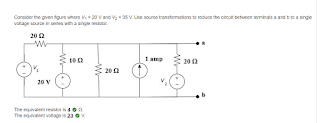Sunday, March 26, 2017
3/23/2017 Class Notes + "Superposition" Lab
3/23/2017
Class Notes:
To start the day, Professor Mason talk about linearity, and how linearity plays a role in circuit. ENGR 44 focuses on linear circuits, where the input is equal to the output. First we did a sample question linearity.
Then we talked about how using linearity we could easily solve for current and voltage by "guessing" the initial voltage drop of a resistor as 1V. After guessing the inital voltage drop as 1, then we find the current if voltage drop were to be 1. After that we find by what factor is the voltage off by. We then multiply the factor to our initial guess of 1, which will give the actual voltage drop over that resistor.
Professor Mason then taught us the art of superposition, which is the fancy term for addition.
Superposition in a linear circuit works wonders! For example if there are 2 voltage sources in the circuit, superposition allows us to calculate by adding the voltages in the 2 circuits which only has 1 voltage source each. It also works on current sources too.
In the case that there is a voltage source and a current source in the circuit,
when we solve for the voltage from the voltage source, we treat the current source as if it is an open circuit.
On the other hand, when we want to solve for the voltage from the current source, we short the circuit, treating the voltage source just as a regular line/connection.
Professor Mason also taught us the art of transforming a voltage source into a current source, and vice versa. The transformation from a voltage source to a current source requires that there is a resistor connected into the voltage source in series, which will then be transformed into a current source that is connected into the resistor with the same resistance in parallel. The current source would have the value of the voltage of the voltage source divided by the resistor.
The other process would be the exact opposite. It requires a current source that is connected to the circuit in parallel, which would then be converted to a current source connected to a resistor with the same resistance in series. The voltage source have the value of the current from the current source multiplied by the resistance of the resistor.
Why is this technique important, one might ask? Well, it could replace a complicated looking part of circuit to a much simpler, like this homework problem
Pretty neat!
Professor Mason also taught us the magic of "everycircuit", which is an awesome tool to check our work with.
"Superposition II " lab
Prelab:
As usual, we change the 20k to a 22k resistor because we don't have a 20k resistor :(
Resistor values:
the "10k":
the "4.7k":
the "6.8k":
the "1k":
the"22k" (a.k.a the poor man's 20k):
Setup:
We first turn on both power supply and measure the voltage drop across the 6.8k ohm resistor,
and we manage to get a 2.70 V drop over it:
We then turn off the 3V voltage source, leaving the 5V voltage source as the only voltage source, which gives us a voltage drop of 1.99V across the 6.8k ohm resistor, giving us a % error of 0.15%.
Something weird happen when we leave the 3V voltage source as the only voltage source, because it gives us a voltage drop of 1.03 V across the 6.8k ohm resistor, which is about 45% error compared to the .708 V theoretical voltage drop that we calculated in the prelab.
The "fix" happens when Jeremy shorted the 5V completely, giving us a reading of .70V, which is only 1.13% error compared to the theoretical voltage drop.
The weird thing is when whether we shorted the 3V or not, we ended up with the same value of 1.99V.
The total voltage drop across the 6.8k ohm resistor when we used superposition without shorting the circuit would be 3.02V, which is about 12.1% error compared to the 2.695 as calculated in the prelab, while if properly shorted the superposition would give a total voltage drop across the 6.8k ohm resistor of 2.70, giving a % error of a tiny amount of 0.19%.
Summary:
When doing superposition in a breadboard circuit using analog discovery box as a power supply, make sure to properly short the unused power supply, in case that it gives a weird value like the 5V power supply. According to Professor Mason, this might be caused by the internal resistance that the box might have. In any case, better safe than sorry.
Also , using superposition and transformation could save so much time in calculating the circuit.
Last but not least, everycircuit is a new tool in our toolbox to check our answer in case we ran out of "check my work" tries in connect homework.
Subscribe to:
Post Comments (Atom)

No comments:
Post a Comment